Engravings and Lithographs
The Gatchina Museum-Preserve’s holdings of engravings and lithographs contain 633 pieces. The collection features colored lithographs and engravings depicting figures in various regimental uniforms that were originally placed in the private rooms of Paul I, Nicholas I and Alexander II, several views of Gatchina parks, portraits of prominent Russian statesmen, and of emperors and members of their families. Some of these were produced by foremost engravers, such as E.P. Chemesov, N.I. Utkin, I. S. Klauber, W. James, Ch.-A. Wortmann.
Some of the most important recent acquisitions include a series of engraved portraits of grand masters of the Order of Malta, purchased in 2012 and produced by the famous French engraver Lourent Cars in the 1720s. These were made to illustrate abbot de Vertot’s book, focusing on the history of the Order of Malta “Histoire des Chevaliers Hospitaliers de St. Jean de Jerusalem, appelles depuis les Chevaliers de Rhodes et aujourd'hui les Chevaliers de Malte» (first published in 1726).
Some of the most important recent acquisitions include a series of engraved portraits of grand masters of the Order of Malta, purchased in 2012 and produced by the famous French engraver Lourent Cars in the 1720s. These were made to illustrate abbot de Vertot’s book, focusing on the history of the Order of Malta “Histoire des Chevaliers Hospitaliers de St. Jean de Jerusalem, appelles depuis les Chevaliers de Rhodes et aujourd'hui les Chevaliers de Malte» (first published in 1726).
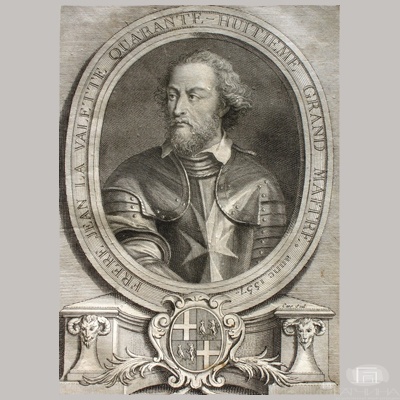 Portrait of Jean Parisot de la Valette
Portrait of Jean Parisot de la Valette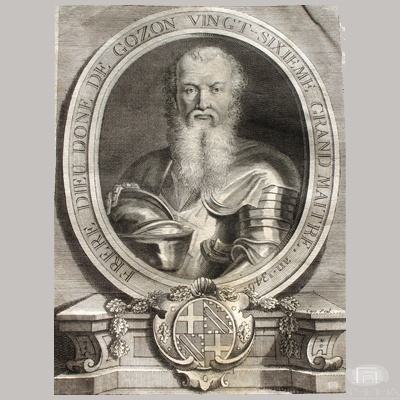 Portrait of Dieudonné de Gozon
Portrait of Dieudonné de Gozon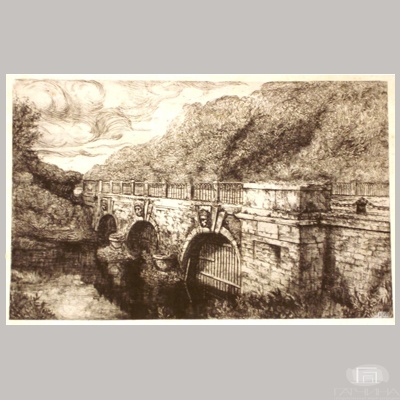 View of the Three-arched Bridge at Gatchina
View of the Three-arched Bridge at Gatchina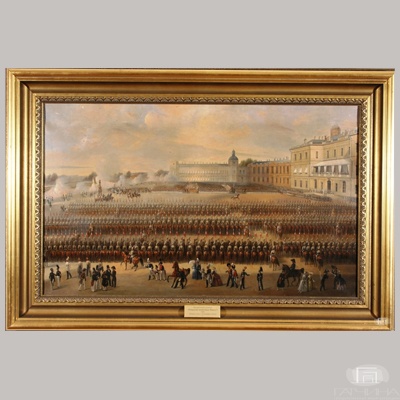 Unveiling the Monument to Paul I at Gatchina
Unveiling the Monument to Paul I at Gatchina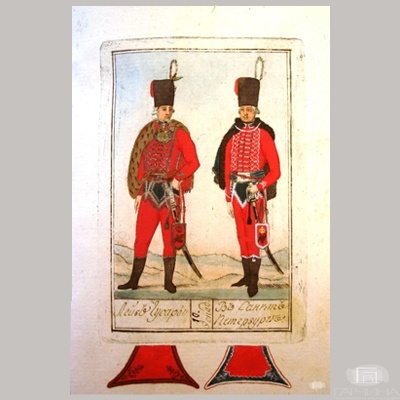 A Sheet from the Album
A Sheet from the Album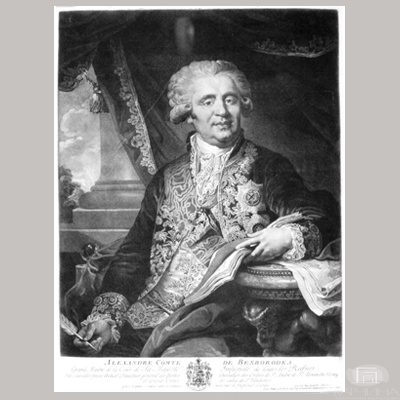 Portrait of A.A. Bezborodko
Portrait of A.A. Bezborodko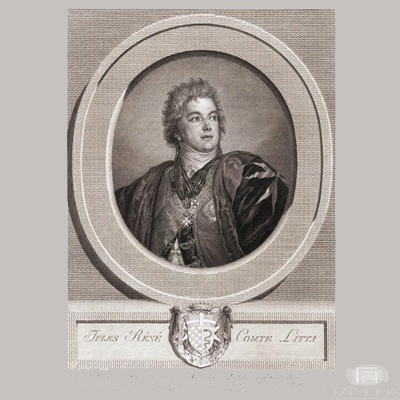 Portrait of Count Yu. P. Litta
Portrait of Count Yu. P. Litta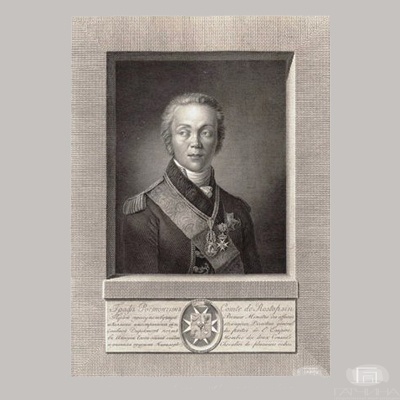 Portrait of Count F.V. Rostopchin
Portrait of Count F.V. Rostopchin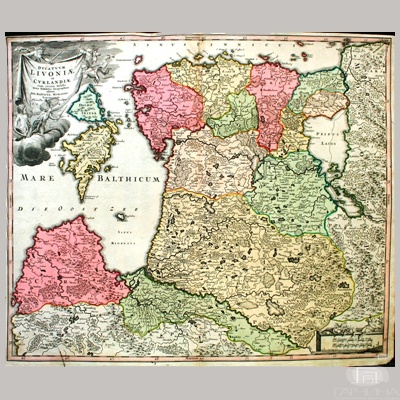 The Map “Duchies of Livonia and Courland...”
The Map “Duchies of Livonia and Courland...”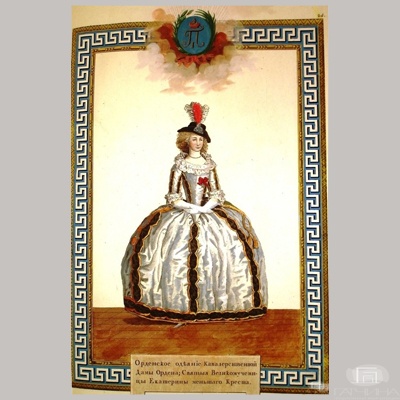 Dame of the Order wearing the insignia of the Order
Dame of the Order wearing the insignia of the Order
Lourent Cars. Portrait of Jean Parisot de la Valette, Grand Master of the Order of Malta. 1720s.
Paper, burin, etching. 20,4х14,5 сm. Inv. № ГДМ-621-IV.
Inscribed in the oval frame: “Frere Jean la Valette quarante-huitieme Grand Maitre Maitre anne. 1557”.
The Portrait of Jean Parisot de la Valette, Grand Master of the Order of Malta, is part of the series of engravings completed by the well-known French engraver Lourent Cars (1699-1771) to illustrate abbot de Vertot’s book, focusing on the history of the Order of Malta “Histoire des Chevaliers Hospitaliers de St. Jean de Jerusalem, appelles depuis les Chevaliers de Rhodes et aujourd'hui les Chevaliers de Malte» (first published in 1726).
Jean Parisot de la Valette (1494—1568) is one of the most prominent figures in the history of the Order of Malta. He became a legendary figure during his life and bards and minstrels sang praises to him in their ballads. He enjoyed an uncontested reputation for his loyalty, bravery and sense of justice. At various points in his career, he served as Admiral of the Order’s fleet and governor of Tripoli. In 1557, la Valette, aged 63, was elected Grand Master and he was over 70 when he led the defense of the city at the Great Siege of Malta in 1565. Due to his strength of courage and enthusiasm displayed in actions during the Great Siege he became an exemplar for younger knights. To honor him, the city of Valette, Malta’s capital, was named after him.
The engraving entered the Gatchina Museum collection in 2012.
Paper, burin, etching. 20,4х14,5 сm. Inv. № ГДМ-621-IV.
Inscribed in the oval frame: “Frere Jean la Valette quarante-huitieme Grand Maitre Maitre anne. 1557”.
The Portrait of Jean Parisot de la Valette, Grand Master of the Order of Malta, is part of the series of engravings completed by the well-known French engraver Lourent Cars (1699-1771) to illustrate abbot de Vertot’s book, focusing on the history of the Order of Malta “Histoire des Chevaliers Hospitaliers de St. Jean de Jerusalem, appelles depuis les Chevaliers de Rhodes et aujourd'hui les Chevaliers de Malte» (first published in 1726).
Jean Parisot de la Valette (1494—1568) is one of the most prominent figures in the history of the Order of Malta. He became a legendary figure during his life and bards and minstrels sang praises to him in their ballads. He enjoyed an uncontested reputation for his loyalty, bravery and sense of justice. At various points in his career, he served as Admiral of the Order’s fleet and governor of Tripoli. In 1557, la Valette, aged 63, was elected Grand Master and he was over 70 when he led the defense of the city at the Great Siege of Malta in 1565. Due to his strength of courage and enthusiasm displayed in actions during the Great Siege he became an exemplar for younger knights. To honor him, the city of Valette, Malta’s capital, was named after him.
The engraving entered the Gatchina Museum collection in 2012.
Lourent Cars. Portrait of Dieudonné de Gozon , Grand Master of the Order of Malta. 1720s.
Paper, burin, etching. 19,6х14,4 сm. Inv. № ГДМ-599-IV.
Inscribed in the oval frame: “Frere Dieu de Gozon Vingt — Sixieme Grand Maitre an. 1346”.
Portrait of Dieudonné de Gozon , Grand Master of the Order of Malta, is part of the series of engravings completed by the well-known French engraver Lourent Cars (1699-1771) to illustrate abbot de Vertot’s book, focusing on the history of the Order of Malta “Histoire des Chevaliers Hospitaliers de St. Jean de Jerusalem, appelles depuis les Chevaliers de Rhodes et aujourd'hui les Chevaliers de Malte» (first published in 1726).
Fra Dieudonné de Goza served as Grand Master of the Order from 1346 to 1353. Legend has it that prior to becoming the grand master he displayed exceptional bravery by killing the dragon that devastated the countryside of the city of Rhodes. De Gozon hunted down the dragon, severed his head with a sword and hung it on the city gates.
After being elected grand master, Fra Dieudonné de Gozon pursued a policy of active resistance against the Muslim forces in the Levant. Throughout his reign, de Gozon twice convened the General Chapter, had new gates and a seaport built in the city of Rhodes.
The engraving entered the Gatchina Museum collection in 2012.
Paper, burin, etching. 19,6х14,4 сm. Inv. № ГДМ-599-IV.
Inscribed in the oval frame: “Frere Dieu de Gozon Vingt — Sixieme Grand Maitre an. 1346”.
Portrait of Dieudonné de Gozon , Grand Master of the Order of Malta, is part of the series of engravings completed by the well-known French engraver Lourent Cars (1699-1771) to illustrate abbot de Vertot’s book, focusing on the history of the Order of Malta “Histoire des Chevaliers Hospitaliers de St. Jean de Jerusalem, appelles depuis les Chevaliers de Rhodes et aujourd'hui les Chevaliers de Malte» (first published in 1726).
Fra Dieudonné de Goza served as Grand Master of the Order from 1346 to 1353. Legend has it that prior to becoming the grand master he displayed exceptional bravery by killing the dragon that devastated the countryside of the city of Rhodes. De Gozon hunted down the dragon, severed his head with a sword and hung it on the city gates.
After being elected grand master, Fra Dieudonné de Gozon pursued a policy of active resistance against the Muslim forces in the Levant. Throughout his reign, de Gozon twice convened the General Chapter, had new gates and a seaport built in the city of Rhodes.
The engraving entered the Gatchina Museum collection in 2012.
K.Nazikov, E.Nazikova. View of the three-arched bridge at Gatchina. 1920s.
Paper, etching, aquatint. 41х58,7 сm. Inv. № ГДМ-461-VI
Inscribed in pencil lower right: “Е. Назикова”. Inscribed in pencil lower left: “K. Nazikoff”. Below in pencil in Cyrillic: “Bridge in the Gatchina Priory Park”
The engraving depicts the bridge encompassing the perspective of the Carp Pond in the Palace Park. The bridge of stone has three arches with lion masks on the keystones. On top of the bridge, there are pillars with metal railings between them. In the foreground, in front of the bridge to the left, one can see a fragment of the Carp Pond, behind the bridge – lush tree crowns of the Priory Park. The bridge was built according to the design of A. D. Zakharov in 1799-1801. The bridge vaults are of brick, while the outside is faced with Chernitsky stone. Located on either side of the bridge are four lower pedestals, on which Zakharov intended to install sculptural groups depicting the “Exuberance of rivers”. This conception, however, remained unfulfilled. In 1944, the Nazi troops blew up the bridge, which has now been restored.
The engraving entered the Gatchina Museum collection in 1992.
Paper, etching, aquatint. 41х58,7 сm. Inv. № ГДМ-461-VI
Inscribed in pencil lower right: “Е. Назикова”. Inscribed in pencil lower left: “K. Nazikoff”. Below in pencil in Cyrillic: “Bridge in the Gatchina Priory Park”
The engraving depicts the bridge encompassing the perspective of the Carp Pond in the Palace Park. The bridge of stone has three arches with lion masks on the keystones. On top of the bridge, there are pillars with metal railings between them. In the foreground, in front of the bridge to the left, one can see a fragment of the Carp Pond, behind the bridge – lush tree crowns of the Priory Park. The bridge was built according to the design of A. D. Zakharov in 1799-1801. The bridge vaults are of brick, while the outside is faced with Chernitsky stone. Located on either side of the bridge are four lower pedestals, on which Zakharov intended to install sculptural groups depicting the “Exuberance of rivers”. This conception, however, remained unfulfilled. In 1944, the Nazi troops blew up the bridge, which has now been restored.
The engraving entered the Gatchina Museum collection in 1992.
Unknown artist. Unveiling the Monument to Paul I at Gatchina. Russia, 1851.
Paper mounted on canvas, lithography, oil. 53,1х86,2 cm. Inv. № ГДМ-575-VI.
The lithograph depicts the parade that occurred in front of the Gatchina palace on the parade ground in August 1851 for the occasion of unveiling the monument to Emperor Paul I by sculptor I. Р. Vitaly. The opening and consecration ceremony began with a liturgy at the Palace’s church, followed by a blessing of water on the Silver Lake. After the blessing of water ritual was over, the procession returned to Paul’s monument on the parade ground. The monument was sprinkled with holy water to the accompaniment of salvos fired by artillery guns located on the meadow and on the bastions. Once the monument was unveiled, there was an inspection of the guards troops that were organized during the reign of Emperor Paul I. The eight-year old Grand Duke Nikolay Alexandrovich, wearing the uniform of Pavlovksy Guards Regiment, led the 1st platoon of the regiment in the inspection, while the six-year-old Alexander Alexandrovich (the future emperor Alexander III) in the soldier’s uniform of Pavlovsky Regiment stood on sentry duty by the monument.
The lithograph comes from the Gatchina Palace’s original collection and was placed in the study of Emperor Alexander II.
Paper mounted on canvas, lithography, oil. 53,1х86,2 cm. Inv. № ГДМ-575-VI.
The lithograph depicts the parade that occurred in front of the Gatchina palace on the parade ground in August 1851 for the occasion of unveiling the monument to Emperor Paul I by sculptor I. Р. Vitaly. The opening and consecration ceremony began with a liturgy at the Palace’s church, followed by a blessing of water on the Silver Lake. After the blessing of water ritual was over, the procession returned to Paul’s monument on the parade ground. The monument was sprinkled with holy water to the accompaniment of salvos fired by artillery guns located on the meadow and on the bastions. Once the monument was unveiled, there was an inspection of the guards troops that were organized during the reign of Emperor Paul I. The eight-year old Grand Duke Nikolay Alexandrovich, wearing the uniform of Pavlovksy Guards Regiment, led the 1st platoon of the regiment in the inspection, while the six-year-old Alexander Alexandrovich (the future emperor Alexander III) in the soldier’s uniform of Pavlovsky Regiment stood on sentry duty by the monument.
The lithograph comes from the Gatchina Palace’s original collection and was placed in the study of Emperor Alexander II.
Jacob von Lude. A sheet from the album “Representation of the Uniforms of the Russian Imperial Ground Forces (277 images), with a manuscript introduction (7 p.). 1797.
Paper, burin, watercolor, ink. 18х11 сm. Inv. № ГДМ-403-VI.
One of the sheets bears the full title of the album “Representation of the Uniforms of the Russian Imperial Ground Forces. Containing 225 illuminated sheets. Drawn, engraved and illuminated by Jacob von Lude, Captain of Keksgolmsky Musketeer Regiment, in St. Petersburg in the year of 1797”.
The Album has a green leather binding with ornaments embossed in gold; marbled endpapers. One of the sheets (№2) bears a dedication to Paul I and background information on J. von Lude, with the following sheets listing regiments. The subsequent sheets are engravings painted in watercolors. Each sheet depicts one or two figures wearing uniforms adopted during the reign of Paul I. The figures are shown against the landscape with a low viewpoint. The image has borders. Below the images, there is a caption with the name of the regiment and details about it. Some of the sheets have standards, grenadier caps, saddles, and saddlebags depicted next to the border. The present sheet shows service men wearing uniforms of Guard Hussars.
The album comes from the Gatchina Palace’s original collection and was placed in the Secretary’s Room of Paul I.
Paper, burin, watercolor, ink. 18х11 сm. Inv. № ГДМ-403-VI.
One of the sheets bears the full title of the album “Representation of the Uniforms of the Russian Imperial Ground Forces. Containing 225 illuminated sheets. Drawn, engraved and illuminated by Jacob von Lude, Captain of Keksgolmsky Musketeer Regiment, in St. Petersburg in the year of 1797”.
The Album has a green leather binding with ornaments embossed in gold; marbled endpapers. One of the sheets (№2) bears a dedication to Paul I and background information on J. von Lude, with the following sheets listing regiments. The subsequent sheets are engravings painted in watercolors. Each sheet depicts one or two figures wearing uniforms adopted during the reign of Paul I. The figures are shown against the landscape with a low viewpoint. The image has borders. Below the images, there is a caption with the name of the regiment and details about it. Some of the sheets have standards, grenadier caps, saddles, and saddlebags depicted next to the border. The present sheet shows service men wearing uniforms of Guard Hussars.
The album comes from the Gatchina Palace’s original collection and was placed in the Secretary’s Room of Paul I.
James Walker, after J.B. Lampi the Elder. Portrait of A.A. Bezborodko. Early 1790s.
Paper, mezzotint. Sheet: 41х38 сm, plate: 38х28 сm. Inv. № ГДМ-466-VI.
Inscribed at bottom, in the center: «grave d`apres l`original dans sa collection pein par le professeur Lampi»; at right: «par son tres humble Serviteur James Walker graver. de Sa Maj. Imp. et memb.re de l`Academie de beaux Arts St.Petg.».
Below the portrait, on either side of the coat of arms: «Alexandre Comte de Bezborodka Grand Maitre de la Cour de Sa Majeste Imperiale de toutes les Russies Son Conseiller privé Actuel. Directeur general des postes Chevalier des Ordres de St. André de St. Alexandre Newsky et Grand Croix de celui de St. Vladimir».
James Walker (1748-1808), an eminent English engraver, worked in Russia for over 20 years. He taught engraving at the Russian Academy of Arts, in 1786 he became its corresponding member, in1794 – a full member of the Academy. He later served as an advisor to the Academy. Walker reproduced paintings from Catherine II’s Hermitage collection using a mezzotint technique and executed a series of portraits depicting prominent Russian people of the time. Alexander Andreevich Bezborodko (1747-1799) was a well-known statesman, who served as Director of the Postal Department from 1782, became count of Russian Empire in 1784 and senator and prince of the Russian Empire in 1797. He is shown wearing the orders of St. Andrew the First-Called (with a ribbon and star), of St. Vladimir (a ribbon and star), of St. Alexander Nevsky (a ribbon and cross). A.A. Bezborodko offered Walker to supervise engraving of Russian, French and Italian paintings from his collection on conditions favorable to the engraver. The project remained unrealized due to the count’s death.
The portrait comes from N.V. Vyrobov’s collection and entered the Gatchina Museum-Preserve in 1993.
Paper, mezzotint. Sheet: 41х38 сm, plate: 38х28 сm. Inv. № ГДМ-466-VI.
Inscribed at bottom, in the center: «grave d`apres l`original dans sa collection pein par le professeur Lampi»; at right: «par son tres humble Serviteur James Walker graver. de Sa Maj. Imp. et memb.re de l`Academie de beaux Arts St.Petg.».
Below the portrait, on either side of the coat of arms: «Alexandre Comte de Bezborodka Grand Maitre de la Cour de Sa Majeste Imperiale de toutes les Russies Son Conseiller privé Actuel. Directeur general des postes Chevalier des Ordres de St. André de St. Alexandre Newsky et Grand Croix de celui de St. Vladimir».
James Walker (1748-1808), an eminent English engraver, worked in Russia for over 20 years. He taught engraving at the Russian Academy of Arts, in 1786 he became its corresponding member, in1794 – a full member of the Academy. He later served as an advisor to the Academy. Walker reproduced paintings from Catherine II’s Hermitage collection using a mezzotint technique and executed a series of portraits depicting prominent Russian people of the time. Alexander Andreevich Bezborodko (1747-1799) was a well-known statesman, who served as Director of the Postal Department from 1782, became count of Russian Empire in 1784 and senator and prince of the Russian Empire in 1797. He is shown wearing the orders of St. Andrew the First-Called (with a ribbon and star), of St. Vladimir (a ribbon and star), of St. Alexander Nevsky (a ribbon and cross). A.A. Bezborodko offered Walker to supervise engraving of Russian, French and Italian paintings from his collection on conditions favorable to the engraver. The project remained unrealized due to the count’s death.
The portrait comes from N.V. Vyrobov’s collection and entered the Gatchina Museum-Preserve in 1993.
Iohann-Sebastian Klauber, after A.K Vighi. Portrait of Count Yu. P. Litta. 1804.
Paper, burin. Sheet: 36,9х27,1 cm, plate: 33,2х23,5 cm. Inv. № ГДМ-492-VI.
Inscribed below the image at left: «Peint par Wighy à S. Petersbourg 1803». At right: «Gravé par Ig. Seb. Klauber 1804». Lower in the center: «Dédié à S. E. Madame la Comtesse Litta née ďEngelhard Dame ďhonneur de S. M. Impériale de toutes les Russies Dame de ĽOrdre de St. Catherine et Grand Croix de ľOrdre de S. Jean de Jerusaleme». At lower right: «Par son tres humble et tres obeissant Serviteur Ignace Sebast Klauber». Below the medallion on both sides of the coat of arms: «Jules Réné Comte Litta».
The portrait depicts Count Giulio Renato de Litta, known in Russia as Yuli Pompeevich Litta (1763-1839). Litta, aged 19, joined the Order of Malta and became Captain of the Grand Master galley at the age of 22, from 1795 he served as plenipotentiary envoy of the Order at the court of Catherine II. Once Paul I assumed the title of Grand Master, Litta was appointed as Lieutenant Grand Master and chef of the Chevalier Regiment. Under emperors Alexander I and Nicholas I, Litta’s career continued to evolve. Alexander I made him a member of the State Council, while Nicholas I granted him, in 1826, Russia’s highest award – the Order of St. Andrew the First-Called.
Litta is shown in the portrait wearing the uniform of Bailiff of the Russian Grand Priory (Catholic) of the Order of Malta, the uniform is decorated with gold embroidery and dark and blue piping, he has a waistcoat on with a black mantle draped over his shoulders. He wears the ribbon and the star of the Order of St. Alexander Nevsky, a badge of the Order of St. George, 3rd class, and Grand Cross of the Order of Malta.
The portrait comes from N.V. Vyrobov’s collection and entered the Gatchina Museum-Preserve in 1993.
Paper, burin. Sheet: 36,9х27,1 cm, plate: 33,2х23,5 cm. Inv. № ГДМ-492-VI.
Inscribed below the image at left: «Peint par Wighy à S. Petersbourg 1803». At right: «Gravé par Ig. Seb. Klauber 1804». Lower in the center: «Dédié à S. E. Madame la Comtesse Litta née ďEngelhard Dame ďhonneur de S. M. Impériale de toutes les Russies Dame de ĽOrdre de St. Catherine et Grand Croix de ľOrdre de S. Jean de Jerusaleme». At lower right: «Par son tres humble et tres obeissant Serviteur Ignace Sebast Klauber». Below the medallion on both sides of the coat of arms: «Jules Réné Comte Litta».
The portrait depicts Count Giulio Renato de Litta, known in Russia as Yuli Pompeevich Litta (1763-1839). Litta, aged 19, joined the Order of Malta and became Captain of the Grand Master galley at the age of 22, from 1795 he served as plenipotentiary envoy of the Order at the court of Catherine II. Once Paul I assumed the title of Grand Master, Litta was appointed as Lieutenant Grand Master and chef of the Chevalier Regiment. Under emperors Alexander I and Nicholas I, Litta’s career continued to evolve. Alexander I made him a member of the State Council, while Nicholas I granted him, in 1826, Russia’s highest award – the Order of St. Andrew the First-Called.
Litta is shown in the portrait wearing the uniform of Bailiff of the Russian Grand Priory (Catholic) of the Order of Malta, the uniform is decorated with gold embroidery and dark and blue piping, he has a waistcoat on with a black mantle draped over his shoulders. He wears the ribbon and the star of the Order of St. Alexander Nevsky, a badge of the Order of St. George, 3rd class, and Grand Cross of the Order of Malta.
The portrait comes from N.V. Vyrobov’s collection and entered the Gatchina Museum-Preserve in 1993.
Iohann-Sebastian Klauber, after S. Tonchi. Portrait of Count F.V. Rostopchin. 1800.
Paper, burin. Sheet: 42,5х30,4 сm; plate: 38,8х27,7 сm. Inv. № ГДМ-491-VI.
Inscribed below the image (in Russian): «Count Rostopchin / Member of the Collegium of Foreign Affairs, / Principal Director of the Post / in the Empire, the member of both councils / and bearer of many orders». At right: «Comte de Rostopsin / Premier Minister des affaires / étrangéres, Directeur général / des postes de l’Empire. Mambre des deux Conseils / Chevalier de pluseurs ordres ». Below the portrait at left: “Peint par Tonci à St. Petersbourg. 1800.”; at right: “et gravé la même année par Ig. Seb. Klauber». Lower: « Dedié à Son Excellence Madame la Comtesse de Rostopsin». Lower at right: «Par son t très humble et très obeissant Serviteur Ignace Sebast. Klauber».
Iohann-Sebastian Klauber (1753/1754-1817), a prominent engraver of German origin, worked for a number of years in Rome, Paris, and St. Petersburg. From 1796 to 1817, he directed an engraving class at the St. Petersburg Academy of Arts. His works include engraved portraits of the members of the Imperial family and famous public figures of Russia from the late 18th to the early 19th centuries. F.V. Rostopchin’s portrait was completed and based on the painted original by S. Tonchi. Feodor Vasilievich Rostopchin (1763-1826) was general of the infantry and a close associate of Paul I. Rostopchin’s influence on Russian foreign policy was significant at the closing of the 18th century. The engraved portrait shows F.V. Rostopchin wearing a uniform with orders of St. Andrew the First-Called, St. John of Jerusalem, and with the chain and badge of the Supreme Order of the Most Holy Annunciation.
The portrait comes from N.V. Vyrobov’s collection and entered the Gatchina Museum Reserve in 1993.
Paper, burin. Sheet: 42,5х30,4 сm; plate: 38,8х27,7 сm. Inv. № ГДМ-491-VI.
Inscribed below the image (in Russian): «Count Rostopchin / Member of the Collegium of Foreign Affairs, / Principal Director of the Post / in the Empire, the member of both councils / and bearer of many orders». At right: «Comte de Rostopsin / Premier Minister des affaires / étrangéres, Directeur général / des postes de l’Empire. Mambre des deux Conseils / Chevalier de pluseurs ordres ». Below the portrait at left: “Peint par Tonci à St. Petersbourg. 1800.”; at right: “et gravé la même année par Ig. Seb. Klauber». Lower: « Dedié à Son Excellence Madame la Comtesse de Rostopsin». Lower at right: «Par son t très humble et très obeissant Serviteur Ignace Sebast. Klauber».
Iohann-Sebastian Klauber (1753/1754-1817), a prominent engraver of German origin, worked for a number of years in Rome, Paris, and St. Petersburg. From 1796 to 1817, he directed an engraving class at the St. Petersburg Academy of Arts. His works include engraved portraits of the members of the Imperial family and famous public figures of Russia from the late 18th to the early 19th centuries. F.V. Rostopchin’s portrait was completed and based on the painted original by S. Tonchi. Feodor Vasilievich Rostopchin (1763-1826) was general of the infantry and a close associate of Paul I. Rostopchin’s influence on Russian foreign policy was significant at the closing of the 18th century. The engraved portrait shows F.V. Rostopchin wearing a uniform with orders of St. Andrew the First-Called, St. John of Jerusalem, and with the chain and badge of the Supreme Order of the Most Holy Annunciation.
The portrait comes from N.V. Vyrobov’s collection and entered the Gatchina Museum Reserve in 1993.
Johann Baptista Homann. The map of“Duchies of Livonia and Courland with Adjacent Islands, Published by Johann Baptista Homann” («Ducatum Livoniae et Gurlandiae cum vicinis insulis Nova Exhibitio Geographica editore Ioh. Baptista Homanno Norimbergae»). Nuremberg.1716(?).
Paper, etching, burin, hand-painted in watercolors. Sheet: 52,0х60,2 сm, plate: 49,0х58,4сm. Inv. № ГДМ-551-VI.
The editor and publisher of the map was Johann Baptista Homann (1664-1724), the Imperial Geographer at the court of Charles VI, the Emperor of the Holy Roman Emperor, and the founder of Europe’s most famous dynasty of cartographers. Homann established his own publishing house «Ioh. Baptisto Homanno» in 1702.
The maps he produced were remarkable for their precision, details and exquisitely decorated cartouches. “Duchies of Courtland and Livonia…” belongs to one of Homann’s earliest maps. It shows Livonia, Courtland, Estonia, Polonika and islands in the Baltic Sea. The sheet indicates hundreds of names for various settlements, with designated rivers, lakes and forests on it. At top left, there is a name of the map depicted on the flag that is supported by five putti armed with lances and backswords. This engraved map was part of «Grosser Atlas über die ganze Welt» (Atlas of all the World), which Homann published in 1716.
The map entered the Gatchina Museum-Preserve in 2007.
Paper, etching, burin, hand-painted in watercolors. Sheet: 52,0х60,2 сm, plate: 49,0х58,4сm. Inv. № ГДМ-551-VI.
The editor and publisher of the map was Johann Baptista Homann (1664-1724), the Imperial Geographer at the court of Charles VI, the Emperor of the Holy Roman Emperor, and the founder of Europe’s most famous dynasty of cartographers. Homann established his own publishing house «Ioh. Baptisto Homanno» in 1702.
The maps he produced were remarkable for their precision, details and exquisitely decorated cartouches. “Duchies of Courtland and Livonia…” belongs to one of Homann’s earliest maps. It shows Livonia, Courtland, Estonia, Polonika and islands in the Baltic Sea. The sheet indicates hundreds of names for various settlements, with designated rivers, lakes and forests on it. At top left, there is a name of the map depicted on the flag that is supported by five putti armed with lances and backswords. This engraved map was part of «Grosser Atlas über die ganze Welt» (Atlas of all the World), which Homann published in 1716.
The map entered the Gatchina Museum-Preserve in 2007.
E.Koshkin, etc. Dame Grand Cross of the Order of St. Catherine the Great Martyr wearing the insignia of the Order from the Album “The Statutes of Paul I of the Russian orders with representations of insignia and dresses worn by Knight and Dame Commanders”. 1797.
Paper, burin, watercolor. 47,6x31,7 сm. Inv. № ГДМ-439-VI.
Depicted in the in the centre of the sheet, a female figure wears a gown of silver brocade with patterned gold embroidery and dark green trim. A silver-edged crimson sash with the cross is worn over the right shoulder, the Order’s Star is on the breast. She has a cap of dark green velvet with diamonds and red and white feathers; in her left hand – a fan. The image is bordered with a rectangular frame of blue color with a yellow fringe. On the blue background of the frame there is a white meander ornament; at the top of the sheet are the initials “П I” below the imperial crown on the blue ground. The initials are surrounded with palm and laurel fronds bound with a red ribbon; encircling the initials are clouds and rays. Inscribed lower in the frame: “Dame Grand Cross of the Order of Saint Catherine the Great Martyr, wearing her insignia”. In addition to this sheet, the album contains 38 engravings, painted in watercolors, showing insignia and official dresses worn by knight and dame commanders of the Russian orders, as well as the text “The Imperial Statutes of the Russian Orders” on 13 pages. The album comes from the Gatchina Palace’s original collection and was preserved in the Engraving Room before World War II.
Paper, burin, watercolor. 47,6x31,7 сm. Inv. № ГДМ-439-VI.
Depicted in the in the centre of the sheet, a female figure wears a gown of silver brocade with patterned gold embroidery and dark green trim. A silver-edged crimson sash with the cross is worn over the right shoulder, the Order’s Star is on the breast. She has a cap of dark green velvet with diamonds and red and white feathers; in her left hand – a fan. The image is bordered with a rectangular frame of blue color with a yellow fringe. On the blue background of the frame there is a white meander ornament; at the top of the sheet are the initials “П I” below the imperial crown on the blue ground. The initials are surrounded with palm and laurel fronds bound with a red ribbon; encircling the initials are clouds and rays. Inscribed lower in the frame: “Dame Grand Cross of the Order of Saint Catherine the Great Martyr, wearing her insignia”. In addition to this sheet, the album contains 38 engravings, painted in watercolors, showing insignia and official dresses worn by knight and dame commanders of the Russian orders, as well as the text “The Imperial Statutes of the Russian Orders” on 13 pages. The album comes from the Gatchina Palace’s original collection and was preserved in the Engraving Room before World War II.
